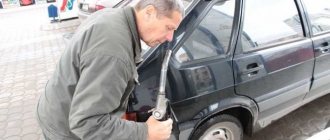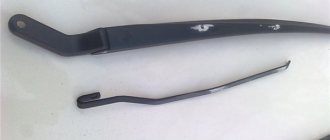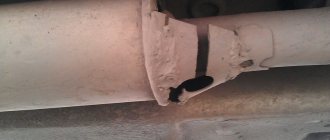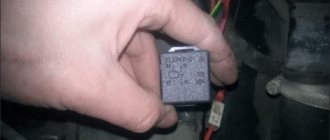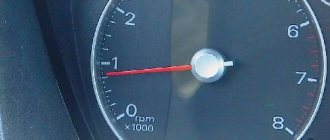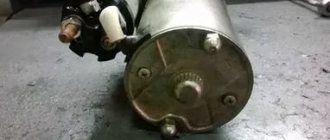Quite often, owners are interested in why the car does not start during startup, even though the starter turns as it should. It is worth noting that such problems usually arise with products from the Volzhsky Automobile Plant.
Quite often the following happens - the VAZ-2115 seizes, but does not start. As practice shows, such a nuisance usually occurs at the most inopportune moment, when the car is far from car services. Such a breakdown can occur at any time of the year, and under a variety of circumstances.
It is for this reason that any car owner needs to know why this happens and how to fix the problem. In fact, in some cases, failure to start the engine is caused by a fairly easily repairable breakdown that even an inexperienced driver can handle.
Ignition problems
Most often, the reason lies precisely in one component of the ignition system. Weaknesses that are the first to come under suspicion are:
- egnition lock;
- induction coils;
- starter and ignition relay;
- lack of voltage at the battery terminals.
Most often, the problem lies in a banal lack of voltage at the ignition switch contacts. It is supplied directly from the battery to the starter.
If, after turning the key, the dashboard goes out or does not light up at all, it may be a problem with the cylinder.
Checking the functionality of the ignition switch is relatively simple:
- it is necessary to dismantle the larva;
- Using a multimeter, the contacts are called in different positions.
If there is no contact, then you should simply purchase a new lock. It simply doesn't make sense to repair it.
You need to pay attention to the behavior of the car immediately after turning the key. If there is no characteristic clicking sound from the side of the door from under the panel, the relay has probably failed. It is located above the clutch pedal.
Like the ignition switch, it simply does not make sense to repair such a relay. You need to purchase a new one and install it in place. You also need to check the ignition coils. Often the spark on the spark plugs disappears due to their failure. The test must be carried out by removing the coil and connecting it to the tester. You should ring the windings - a break in one may be the cause of the malfunction.
If you have problems starting the engine in cold weather, you should make sure that the battery is working properly. Often it simply fails.
It is not difficult to check the condition of the battery using a conventional tester - you need to switch it to the constant voltage measurement mode and set it to the 20 V limit.
The voltage between the terminals should be 12.6 V. It would also be a good idea to measure the density of the electrolyte using a hydrometer.
Twist
To twist, you will need a Phillips screwdriver and a paper clip (piece of wire).
- Open the hood and remove the wire from the positive terminal of the battery.
- Place the gear shift lever in neutral position.
- Put the car on the parking brake.
- Using a Phillips screwdriver, remove the steering column boot and set it aside.
- Carefully remove the block with wires from the ignition switch. Immediately determine which wire is ground and disconnect it from the others. If you connect the ground to the housing with a multimeter, there will be no voltage. It's even better if you insulate the cable so you don't accidentally damage all the wiring.
- Find the red wire and move it to the side. Carefully connect the remaining wires to make contact. Secure the twist with wire or a paper clip. Sometimes the twist is rewound with tape or tape. The electrical equipment of your car should turn on.
- Depress the clutch pedal.
- Place the red wire with the rest of the wires (twisted). The car should start. Remove the red wire from the twist. If the engine speed is stable, release the clutch pedal smoothly and carefully.
The ignition switch connectors (blocks) on different cars may differ from each other. There are types of connectors from which you can remove the wires with an awl. Only after removal are they twisted together (without the red wire).
After starting the engine, the red wire is immediately removed from the twist. Otherwise the starter may break.
Attention! If you do not remove the wire from the battery terminal, the engine may start when twisting the wires and a short circuit may occur.
Winding by short circuit
Fuel supply: fuel pump failure and other reasons
If all of the above problems are absent, then you should check the performance of the fuel system. Often the reason lies in the following:
- the fuel pump has failed;
- low pressure level in the fuel line;
- the filter is clogged;
- the injectors are out of order;
- low pressure in the ramp.
You need to remember: it is quite difficult to check the performance of the fuel pump on cars with an injection engine. You can determine its performance by its sound - immediately after turning on the ignition, it should definitely make noise. If the fuel pump is faulty, it will need to be replaced. Such devices do not require repair.
You should check the pressure level in the fuel line and rail. To do this you will need to use a special pressure gauge. The normal pressure level for VAZ 2115 and VAZ 2114 is from 2 to 2.5 atm.
If this indicator is lower than specified, then the car will have poor grip and stall while driving. In this case, it will be difficult to fix the problem yourself. It is worth contacting a car service. It often leaks at the ramp connection point.
When a car has a high mileage and uses relatively low quality fuel, the problem often lies in a clogged filter. It needs to be replaced. The cost of a filter is usually no more than 250-300 rubles. Often the problem is also due to poor quality fuel in the injectors - they are simply clogged. Moreover, in some regions, even branded gas stations sell relatively low quality fuel.
Cleaning them requires special equipment. But often the injectors do not cope with their function due to lack of power. Checking its presence or absence is relatively simple - just disconnect the special connector and use a tester.
As in the case of measuring the voltage on the battery, you need to set the measurement limit to 20 V. The voltage should be 12 V. Lack of power indicates the need to check the wiring for an open circuit.
In some cases, the problem lies in armored wires and candlesticks. It is enough to replace the power cables that supply voltage from the coil to the spark plug - and the motor begins to operate smoothly and unpretentiously.
Starter failure
If all other system components are in order, then the reason for the inability to start may lie in the absence of a starter. Typical problems:
- poor contact at the terminals;
- the starter shaft bearing has failed;
- The solenoid relay has stopped working.
It should be noted: the location of the power terminals on the starter suggests the presence of moisture. Therefore, often the contact simply oxidizes, which leads to problems in the operation of the device. That is why you need to carefully examine the contacts. Then clean them and check the voltage. If it is missing, there may be a break in the wiring.
When there is voltage, but the starter does not turn, it is often a problem with the bearings. To replace it, you will need a clean garage, as well as a special puller. This is the only way to dismantle it.
A little more often than a bearing, the solenoid relay fails. Sometimes it just jams - just tap it lightly with the key.
It is very simple to check the functionality of the retractor - just place the starter on the engine block and then touch the contact of the wiring relay connected to the positive terminal. If the starter starts spinning, it means the solenoid relay is in working condition. All of the problems listed above are typical and do not require any major repairs.
Radical approach
If there is no time, and nerves are at their limit, some car enthusiasts resort to them, but these are the worst ways to open a car. Imagine that you decided to sell your car in a year, and the buyer you came across was attentive and meticulous. Traces after an approach by brute force will remain with a 99% probability, and such a car will be sold for a very long time, because no one will believe that it was not in an accident.
If you decide then:
- We break out the lock - take a screwdriver and hammer it into the lock cylinder, and then turn it. This method is incredibly expensive, because further repairs are required. You will be faced with the fact that instead of one cylinder you will have to change all 5 (doors + trunk), and after the repair you will have two keys. In order to have only one key, you will have to order expensive locks and wait a long time, dooming yourself to the inability to use the car always open.
Breaking the lock
- We break the glass - when you damage the lock, but do not open the car, break the glass. It is necessary to break the rear door glass (preferably the right one). There are several reasons for this decision: firstly, a window sealed with tape will not spoil visibility, and secondly, if after breaking it turns out that the back door of the VAZ 2114 does not open, and you have to knock out all the glass to get through, you will have less wind later. And don’t break the glass with your hands - find a hammer, otherwise, in addition to a car mechanic, you will also need a surgeon.
Breaking out the glass
WORTH KNOWING! Another tip is to buy the tape in advance, because if the fragments hang on it, you will not have to clean the interior. Imagine the area you are going to hit as a square and cover it with tape on only one side.
Other reasons for the inability to start the engine
Figuring out why the engine stalls is not difficult. In addition to typical problems, the following types of problems may be present:
- timing belt is broken;
- the engine “knocked”;
- the shaft is jammed.
A fairly common problem, especially on 16-valve engines, is a broken timing belt. In this case, the valves on the VAZ 2115 bend. Such breakdowns not only lead to the inability to start the engine. But they require a complete engine overhaul. The situation is similar if the engine knocks. If you can’t start the car even when it’s hot, you should check the air supply channel. Moreover, starting is not always possible the first time.
There are many nuances associated with setting the ignition and ensuring normal engine operation. You will need to carefully understand all the subtleties and nuances. Many problems associated with the inability to start the VAZ 2115 engine are associated with typical malfunctions and repairs take a minimum of time.
Why does the VAZ-2115 catch but won’t start and what to do
Quite often, owners are interested in why the car does not start during startup, even though the starter turns as it should. It is worth noting that such problems usually arise with products from the Volzhsky Automobile Plant.
Quite often the following happens - the VAZ-2115 seizes, but does not start. As practice shows, such a nuisance usually occurs at the most inopportune moment, when the car is far from car services. Such a breakdown can occur at any time of the year, and under a variety of circumstances.
It is for this reason that any car owner needs to know why this happens and how to fix the problem. In fact, in some cases, failure to start the engine is caused by a fairly easily repairable breakdown that even an inexperienced driver can handle.
Candles
If they do not produce sparks, even with new filters a situation will arise where the VAZ-2115 will not start.
And, as you know, not only gasoline, but also air is supplied into the chamber. If the amount of the latter is insufficient, starting the engine will be difficult.
The car seizes, but the engine cannot start
Most often, this problem occurs in the cold, in the morning, after the car has spent the night in the open air or in an unheated garage. This often results from insufficient vehicle maintenance.
Troubles of this kind happen equally with both carburetor and injection machines. There are many reasons for refusal. Most often they are the following:
- any malfunction of the fuel supply system;
- electrical equipment failure.
It is important to always remember that starting an engine in winter differs in many ways from the same procedure carried out in the warm season.
Fuel system
As you know, the method of supplying fuel to carburetor and injection power units is different.
Nevertheless, the faults that manifest themselves are largely identical. In particular, in both cases gasoline is supplied using a pump. If in the first this unit operates on a mechanical drive, then in the second on an electric drive, which creates a fairly high pressure in the fuel supply system.
Both pumps have filter meshes in their design that purify gasoline. If they become clogged, the engine will not be able to start.
In addition, the pump electric motor fails if:
- no food;
- there was a wiring break;
- no mass added;
- The fuse has blown.
A carburetor unit will not start if the jets are clogged. Nevertheless, experience proves that most often cars driven by injection engines cannot start due to problems with the fuel system. The thing is that the design of such engines includes several special sensors that supply data to the on-board computer.
For example, if the DPKV fails, then the car will almost certainly not move. Similar problems occur due to a breakdown of the fuel pressure regulator. Engine injectors may also be to blame.
Failure of the fuel pump is detected quite simply. After turning on the ignition, you need to listen in the area of the rear seats to see if you can hear the characteristic sound of this important unit starting up.
Electricity problems
If fuel is supplied to the engine, but starting does not occur, you should look for an electrical failure.
First of all, you need to inspect the ignition. May not work:
- candles;
- coil;
- spark distributor.
It never happens that all nodes fail at the same time, so it is necessary to talk about each of them in more detail. In particular, if there are no problems with the ignition distributor, then most likely there is a breakdown of either the slider or the cover. The engine may not start due to a Hall sensor failure.
But the most common problem is improper contact at the supply terminal of the ignition distributor. However, the problem often arises due to the inability of the coil to produce the required voltage. As you know, the injector works together with the ignition module. There are two of them in the engine design. The first is in charge of the functioning of the 1st and 4th cylinders, the other, respectively, of the second and third.
As a result, even when the spark plugs are dry, a spark does not appear on them.
It may well be that the problem arose in the ECU, since it is in charge of generating commands for each installed system, and ignition is no exception. The only way to check the functionality of the on-board computer is to replace it with a known working unit. The suitability of the ignition module is checked in the same way.
If, however, a breakdown occurs in the coil, then a fairly simple test will allow you to verify its malfunction. The spark plugs are unscrewed from their sockets without removing the wires and placed against the ground of the car. Next, turn the starter. If a spark does not appear, it means that the coil has become unusable and cannot produce enough voltage to ignite the fuel.
It is also worth pointing out that the reason why the car does not want to start sometimes lies in the spark plugs themselves. It is this element that is responsible for the ignition of the fuel-air mixture. During operation, their metal parts burn out, which leads to an increase in the gap. The latter circumstance often either complicates the launch or makes it impossible. You should check the gap more often, and then no problems with the spark plugs will arise.
About spark plug gap
Over time, the gap between the electrodes increases. The normal parameter is from 0.7 mm to one millimeter. You can check this gap using a special feeler gauge.
The same is used for setting valve clearances on carburetor engines. So, if a parameter does not meet the norm, it should be adjusted. To do this, you should use a negative screwdriver. To reduce the gap, press the end of the plug onto the top electrode of the spark plug. With your other hand, hold the part itself. If you “overdid it”, it doesn’t matter – everything can be returned back. To do this, bend the electrode with the edge of a screwdriver (it bends quite easily) and check the distance again. It is worth noting that with a correctly set gap, you can not only ensure trouble-free engine starting, but also reduce fuel consumption by 5 percent. Also the car will run smoothly. After all, the mixture is ignited exactly at the moment when it is necessary. And the last thing is the resource of the candles themselves. If the gap is higher or lower than normal, the risk of breaking through the insulator increases significantly. As for the replacement schedule, it is about 40 thousand kilometers. It is recommended to replace the high-voltage wires along with the spark plugs.
VAZ 2115 car does not start
The car engine does not start. The ignition is on, the fuel pump pumps gasoline, but when you try to start the starter, nothing happens. Quite a common phenomenon on domestically produced cars.
Where to start checking. First of all, there may be a fault in the battery. You can do this. Disconnect the negative terminal from the battery. We wait about 20 minutes, connect the battery terminal to the battery. We are trying to start the car. Usually it helps in many cases.
Of course, if you have someone to turn to for help, you can borrow a known-good battery and connect it instead of the faulty battery. Thus start the engine.
If such manipulations do not help, we look for a fault in the starter circuit. We check the starter relay in the fuse module (not all VAZ models have a starter interlock relay!). Usually the cover indicates which relay is responsible for what. You can check by ear; clicks should be heard when you turn the key to the start position. It happens that the relay sticks and does not click, in this case we replace the relay with a new one or install a jumper.
If this does not help, do the following. Leaving the speed lever in the neutral position, turn on the ignition. We take a flat-head screwdriver and, using the screwdriver, briefly close the two positive contacts on the car starter itself. Usually one contact is screwed with a nut to the starter, and the other contact is pressed onto the terminal. We move the contact that is on the terminal a little, and use the metal part of the screwdriver to connect them to each other.
Starting the car in this way indicates that the starter is working, but the starter circuit is faulty. The fault can only be in two places. In the starter relay and in the ignition key itself. In both cases, you need to replace them with new ones. Although in case of a problem with the solenoid relay, you can solve the problem with an additional relay, which I will talk about a little later in my article.
If you cannot start the car using a screwdriver, then the starter itself is faulty. Of course, the starter needs to be repaired or replaced with a new one. The starter rarely fails.
In winter, the engine must be started correctly
If in the summer the driver’s actions can be described as “sit down and go,” then in the cold season everything is completely different.
Starting the engine in winter should be carried out by adhering to certain rules. Their strict implementation in most cases guarantees a trouble-free launch. So, the first step is to warm up the battery much. This is not difficult to do. The most common option is to turn on the high beams for a few seconds by pulling the corresponding lever towards you. As a rule, 10-15 seconds are enough. This procedure can be done several times - the main thing is not to overdo it and not damage the battery. Next, turn on the ignition and pause. The fuel pump takes a few seconds to supply fuel to the system. After this, you need to depress the clutch pedal. Thanks to this simple action, you make the starter’s job much easier, reducing the number of parts it needs to turn. Accordingly, the current consumed by this device is also reduced, that is, you are also sparing the battery.
Now you can proceed to the final stage, that is, directly starting the engine. It should be especially noted that it is recommended to turn the starter for 5-7 seconds. Otherwise, you risk simply draining the battery, making your task even more difficult. If it fails to start on the first try, take a short pause and then try again. It is recommended to do this no more than 3-4 times.
Situations often arise when all of the above actions were done correctly and in the right sequence, but the car still did not start. In this case, you should look for other problems that are preventing the engine from starting. First of all, you need to pay attention to the candles. If during the inspection you find that they are flooded, you can solve the problem in 2 ways. Firstly, carry a spare set with you and, if necessary, install it. Option two is to simply burn the candles using a gas stove.
So, all the problems are solved, and the engine still starts. Do not rush to immediately release the clutch pedal. Experienced warriors recommend holding it for another 5 seconds. You need to release the pedal very smoothly and carefully so as not to stall. By the way, it is also not recommended to move off immediately after starting - let the oil in the engine and gearbox warm up a little.
Finally, I would like to give a few more simple tips. If you store your car near your home, it is better to take the battery to a warm room overnight. It’s clear that you don’t really want to rush back and forth with a rather weighty battery, but the prospect of not starting in the morning due to a completely discharged battery is even less pleasant. If you still don’t want to do this, then at least buy a set of wires so that you can “light it” from another car if necessary. Here it is worth recalling one very important rule. With this procedure, you should first connect the ground on both cars, and only after that the positive terminals.
Ignition
When a car does not want to start, then most likely there is a problem in its ignition system. This reason, as practice shows, is extremely common. Most often, the lock breaks; somewhat less often, troubles occur with:
- coil;
- starter and its relay;
- battery.
Interestingly, a low battery usually does not interfere with a hot start, but in winter even a full charge may not be enough. Check the voltage supplied by the battery with a tester - normally it should be approximately 11.5 volts.
The problem in question often arises precisely because of the ignition switch. Here, contact deteriorates over time, and this, in turn, does not allow the system’s electrical circuit to be activated. It’s easy to check the functionality of the 2115 model:
- unscrew the lock from the panel;
- turn the key;
- use a tester to test all wires.
If there is no contact, the element is replaced.
Please note that if you do not hear a clunking noise when starting the car, then the ignition relay is most likely broken. It is located in the 2115th model near the driver's door, above the clutch. The element cannot be repaired; it must be replaced.
The ignition coil is checked separately - due to its failure, in particular, the spark on the spark plugs disappears. For testing, the unit must be dismantled. Next, use a multimeter to ring the windings. A short circuit in them or a break is a completely obvious reason explaining the reluctance of the car to start.
Coil
Modern cars are no longer equipped with distributors. There is an ignition module here. VAZ-2115 (16 valves) is no exception. Sometimes breakdowns happen. Because of this, the VAZ-2115 does not start. The reasons are a faulty ignition distributor.
This item cannot be repaired. And in order not to waste time on diagnostics (or if you don’t have a multimeter), it’s worth installing a known-good ignition module. The VAZ-2115 should start without difficulty. Sometimes the high-voltage wires themselves pierce. But in this case the car starts and starts. This can be heard by the characteristic sound of the engine.
Fuel system 2115
When the Lada does not start hot or cold, and none of the above options helped to find the problem, then the reasons may lie in the components and communications responsible for supplying the engine with fuel.
In the case of the 2115th model, the following may happen:
- fuel pump failure;
- pressure drop in the ramp;
- filter clogging;
- injector problems;
- line blockage.
The easiest way to find out if the gasoline pump is working is this:
- try to start the engine;
- listen - the whirring of a motor can be heard from under the back sofa.
If nothing disturbs the silence, then the pump will have to be removed.
Next, the pressure in the fuel line is checked for a car that does not want to start. Install the pressure gauge into the fitting provided for it. On the VAZ-2115, the normal value ranges from 2 to 2.5 atmospheres. When the pressure is lower, the car does not start or stalls while driving. Check the connection points of the pipes - it may be leaking there.
Sometimes the filter also turns out to be faulty - it becomes clogged due to low-quality fuel. As a result, gasoline is not supplied in the required quantity, the pressure drops and the engine does not start. This problem can manifest itself during both hot and cold starts.
Bad fuel also clogs the injectors - this is another frequent breakdown for VAZ. These elements sometimes stop working due to a break in the wires supplying them. The contact may disappear in the armored cables leading to the candlesticks.
Clogged filters
This problem can occur in both summer and winter. And this applies not only to the fuel filter, but also to the air filter. The latter is in a special plastic case. On VAZ 15th model cars it looks like this.
After moving the latches, lift the air filter housing cover and remove the cleaning element itself. If it is dirty, the part needs to be replaced. Filters are consumables and cannot be restored at home. Moreover, they cost pennies. As for the fuel filter, it is located under the bottom of the car. The element looks like in the photo below.
If the car has driven more than 30 thousand kilometers, the filter should be replaced. You will not be able to visually determine the degree of contamination as you can in the air. The part is located in a closed, non-separable case. It has porous paper inside. It is capable of passing particles smaller than 10 microns. Over time, the pores of the paper become clogged, and the filter is not able to pass the required amount of fuel through itself. So that the problem does not take you by surprise, change this part in advance.
A characteristic sign of failure is jerking when moving (as if the fuel supply to the cylinders had stopped for some time). This means that the submersible pump is not able to supply the required amount of fuel through the paper pores. As for the air filter, it is changed every 6 months or every 10 thousand kilometers. By following the regulations, you will protect yourself from such problems.
Starter
In a situation where the car does not start, and the previously described components are in order, then a faulty starter is probably preventing normal starting. This could happen to him:
- poor contact in the wiring;
- breakage of the solenoid relay;
- destruction of the bearing on which the assembly shaft rotates.
The terminals of the cables connected to the starter often become oxidized and dirty. This is the most possible factor preventing the VAZ car of the model in question from starting. If cleaning does not help, then it is possible that there is a break somewhere.
Bearings, as well as brushes and windings are checked when it turns out that voltage is supplied to the starter, but it does not turn. It will have to be removed and disassembled. And sometimes the solenoid relay fails. More often than not it just jams. It helps to bring the device back to life by gently tapping it, for example, with a key.
In general, it is not difficult to find out whether the relay of your VAZ-2115 is functioning. Connect its positive output directly to the corresponding wire coming from the battery.
Other reasons
Malfunctions of this kind are much less common on the VAZ-2115:
- crankshaft jamming;
- timing belt rupture;
- wear of cylinder gaskets.
In the first and last case, you will have to disassemble the engine and replace unsuitable parts. If you are not sure that you can cope with this task, then it is better to entrust it to specialists from a car service center. It’s quite possible to install the belt yourself.
Sometimes problems in the VAZ-2115 arise with hot starts. There is a possibility that the air filter is the culprit. Check it and the lines that are connected to it.
Sources
- ladaprofi.ru/vaz-2115/chto-delat-esli-vaz-2115-ne-zavoditsya.html
- zen.yandex.ru/media/avtovaz/ne-zavoditsia-avtomobil-vaz-2115-5abf28eea815f1eea1996207
- ladaautos.ru/vaz-2115/pochemu-vaz-2115-sxvatyvaet-no-ne-zavoditsya-i-chto-delat.html
- zapchasti.expert/reshenie-problem/ne-zavoditsya/ne-zavoditsya-vaz-2115.html

